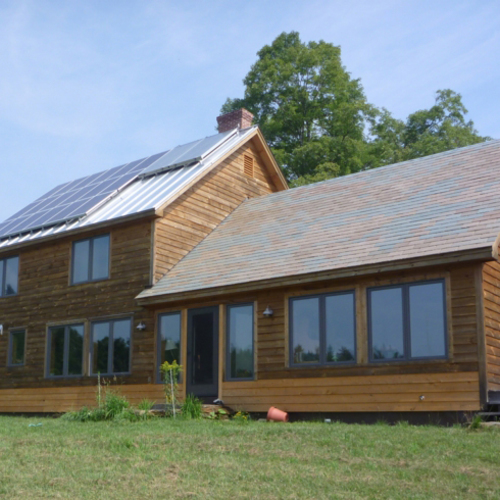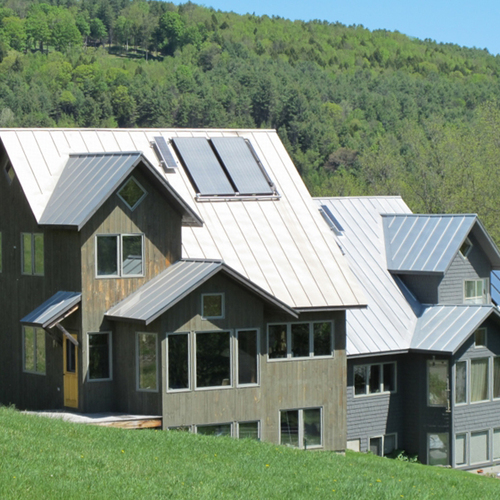
Image Credit: Rachel Wagner
Following the first energy crisis in 1973 there was a rush to heat homes with the sun. It was a tinkerer’s paradise, with all manner of solar heating systems migrating from garage workshops to commercialization. Patent offices were working overtime.
Many of these early systems failed to live up to their promise — some others simply failed. They often depended on multiple pumps, complicated differential thermostats, and dozens of valves, all of which could fail. Complexity ruled the day, and homeowners hoping to harness the sun often lost out in the process. Was solar too complicated to be practical?
Frustration with these “active solar” systems led to a different approach: “passive solar heating.” Rather than relying on complex controls, pumps and fans, passive solar systems operate without moving parts. The building itself serves as the solar collector and also stores and distributes that heat. There are no moving parts to fail, and there’s almost no maintenance required, other than washing windows or solar glazing panels now and then.
The simplest passive solar heating system is often referred to as “direct-gain.” South-facing windows bring sunlight into a house, and that sunlight warms high-thermal-mass materials like concrete floor slabs, brick wall facings, and plaster wall surfaces.
Vertical, south-facing windows are ideal for passive solar heating because during the winter when you want heat, the sun is low in the sky and mostly to the south. In the summer, when the sun is higher in the sky, simple overhangs above windows keep most of the direct sunlight out. Thus, the control works passively. During the daytime, solar energy is absorbed in the thermal mass of the house, and these materials in turn radiate that warmth to the living space in the evening. Passive-solar homes typically have open floor plans allowing the solar heat to be distributed throughout the space.
All this sounds pretty easy—and, in principle, it is. To function well, however, the amount of south-facing glazing, the glazing properties and shading, and the thermal mass inside the home must be carefully balanced to provide useful heat when desired while keeping the space from overheating. Architects and designers work hard to figure all this out. Back in the ’70s, we relied on rules-of-thumb and experience. Today, there are sophisticated software tools that make this process a lot easier and improve the outcome.
Two other passive solar approaches are thermal storage walls (sometimes called Trombe walls, after a French solar pioneer) and attached sunspaces. With thermal storage walls, a solid, south-facing, masonry wall is built, with a layer of glass (or plastic glazing) held a few inches away from that. During the daytime, sunlight shines through the glass and is absorbed by the dark masonry surface. This heat slowly conducts through the wall and then radiates to the interior living space. If the wall is the proper thickness and built of the right material, the heat reaches the interior surface just about the time the sun goes down, and much of the stored heat is delivered at night.
Attached sunspaces are additions on the south side of a house with a lot of glass. During the day they heat up, and windows, doors, or vents connecting the sunspace with the house are opened to bring solar-heated air inside. At night, these connections between sunspace and house are closed and the sunspace drops in temperature, while not robbing the house of heat. Some refer to these as “isolated-gain” passive solar systems.
To work effectively, passive solar homes have to be well-insulated and tightly built. As I noted last week, energy conservation is the top priority. Once heating loads are made as small as possible, passive solar gain can provide a significant percentage of the needed heat. If considering passive solar heating, look for a designer with significant passive-solar experience.
A “Button Up Vermont” workshop is being held Saturday, November 8th, from 10 AM to 2 PM at the Putney Community Center on Christian Square. The featured presenter is Keith Abbott of Thermal House, a leading energy auditing and weatherization company in Jamaica, VT. Other local businesses and experts will also be on hand. The workshop is free and hosted by the Putney Energy Committee and the Dummerston Energy Committee; for information contact Daniel Hoviss at 387-2521 or visit pec.putney.net.
Weekly Newsletter
Get building science and energy efficiency advice, plus special offers, in your inbox.















0 Comments
Log in or create an account to post a comment.
Sign up Log in